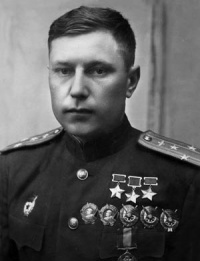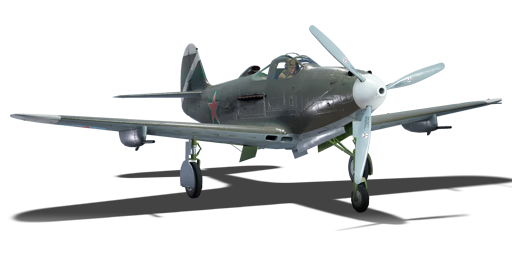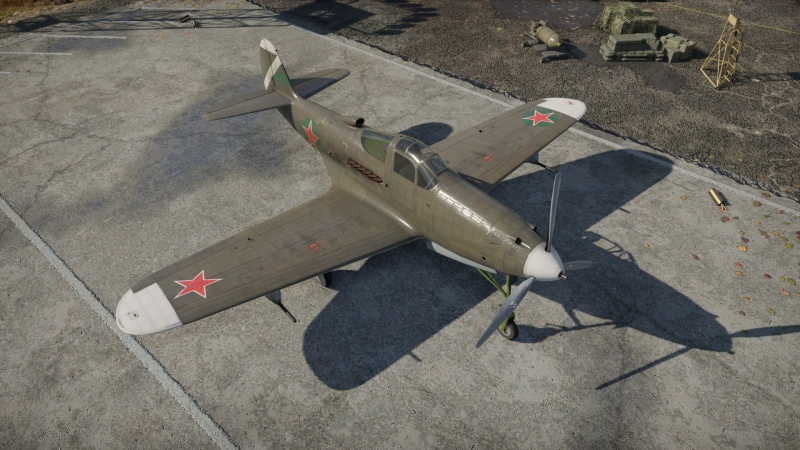P-39Q-15 (USSR)
| This page is about the gift Soviet fighter P-39Q-15 (USSR). For other versions, see P-39 (Family). |
Contents
Description
The ▂P-39Q-15 Airacobra is a premium gift rank III Soviet fighter with a battle rating of 3.3 (AB/RB/SB). It has been in the game since the start of the Open Beta Test prior to Update 1.27. It was gifted to players who participated in the alpha test for a year or more.
General info
Flight performance
Regarding flight performance for its rank, the P-39Q is, for the most part, an excellent aircraft. While not necessarily as manoeuvrable as spitfires of comparable battle rating. Its speed and climb rate can give experienced pilots the upper hand in a lot of fights, if they can utilise it correctly. Ideally, a player should try to avoid turn-fighting as the P-39Q shares a structural design flaw much like its predecessors, namely that the location of the fuel tanks are in the wings. With the fuel tanks situated where they are, this makes them much easier to hit and makes fuel fires more common on the P-39Q, which becomes fatal for the aircraft if the fires cannot be put out.
Note that due to the engine being center mounted in the P-39Q, the plane has a habit of going into horizontal spins in realistic/simulator battles, as the center of gravity has been shifted towards the center of the aircraft rather than tip, so try to avoid low speed manoeuvres while flying with the wings perpendicular to the surface.
| Characteristics | Max Speed (km/h at 3,048 m) |
Max altitude (metres) |
Turn time (seconds) |
Rate of climb (metres/second) |
Take-off run (metres) | |||
|---|---|---|---|---|---|---|---|---|
| AB | RB | AB | RB | AB | RB | |||
| Stock | 596 | 577 | 9000 | 21.1 | 22.0 | 13.3 | 13.3 | 269 |
| Upgraded | 658 | 624 | 19.7 | 20.0 | 23.5 | 17.5 | ||
Details
| Features | ||||
|---|---|---|---|---|
| Combat flaps | Take-off flaps | Landing flaps | Air brakes | Arrestor gear |
| ✓ | ✓ | ✓ | X | X |
| Limits | ||||||
|---|---|---|---|---|---|---|
| Wings (km/h) | Gear (km/h) | Flaps (km/h) | Max Static G | |||
| Combat | Take-off | Landing | + | - | ||
| 886 | 322 | 426 | 396 | 241 | ~13 | ~9 |
| Optimal velocities (km/h) | |||
|---|---|---|---|
| Ailerons | Rudder | Elevators | Radiator |
| < 360 | < 380 | < 450 | > 250 |
Survivability and armour
- 15.87 mm Steel - Propeller hub plate
- 15.87 mm Steel - Instrument panel plate
- 7 mm Steel - Under the front canopy
- 6 mm Steel - Behind the pilot seat
- 6 mm Steel - Headrest frame
- 6 mm Steel - Rear tail plate
- 64 mm Bulletproof Glass - Pilot headrest
- 38 mm Bulletproof Glass - Front canopy
- No armour glazing
- Critical components located at the front of aircraft (fuel, pilot, engine, controls)
- More fuel tanks located in wings near the fuselage
Modifications and economy
Armaments
Offensive armament
The P-39Q-15 (USSR) is armed with:
- 1 x 37 mm M4 cannon, nose-mounted (30 rpg)
- 2 x 12.7 mm M2 Browning machine guns, nose-mounted (200 rpg = 400 total)
- 2 x 12.7 mm M2 Browning machine guns, wing-mounted (300 rpg = 600 total)
The P-39Q represents the epitome of development in the Airacobra fighter series and has finally replaced all of the small calibre machine guns with 12.7 mm machine guns, giving the plane's machine gun fire a much tighter grouping due to a similar trajectory. This weapons give the fighter a much-needed accuracy boost to its secondary armament and makes it a much more viable back up to the 37 mm cannon.
While the 37 mm cannon is indeed effective against all types of aircraft and usually dealt out critical amounts of damage, the pilot must take care to use it only under optimal conditions. The 37 mm projectiles are both slow and inaccurate and firing at targets further than 0.5 km away is optimistic at best, as the shot will not connect. Furthermore, if going against other fighters, the 37 mm tends not to detonate its explosive filler and glance off if it comes in contact with a fighter wing if flying straight behind the aircraft. Always try to fire the 37 mm against fighters only when they expose as much of their plane profile as possible (i.e. in a turn), or when you are close enough to shoot their tail off.
Suspended armament
The P-39Q-15 (USSR) can be outfitted with the following ordnance:
- Without load
- 1 x 250 kg FAB-250sv bomb (250 kg total)
Usage in battles
The general strategy at the start of a match for a P-39Q pilot should, in general, be to climb up and face enemy bombers as a priority, as the P39-Q has an excellent climb rate and will be able to intercept bombers before they can reach their targets. Get in close from a weak spot in the bombers gun coverage and use the 37 mm to destroy them, as bombers are huge targets and easy to hit the 37 mm. When the bombers are no longer a threat, engage enemy fighters. Be mindful of engaging them in direct head-ons as the 37 mm won't be of much use due to low velocity and accuracy.
Manual Engine Control
| MEC elements | ||||||
|---|---|---|---|---|---|---|
| Mixer | Pitch | Radiator | Supercharger | Turbocharger | ||
| Oil | Water | Type | ||||
| Controllable | Controllable Not auto controlled |
Controllable Not auto controlled |
Controllable Not auto controlled |
Separate | Not controllable 1 gear |
Not controllable |
Pros and cons
Pros:
- Powerful 37 mm cannon in the nose
- Great dive speed acceleration/pickup
- Good secondary armament of four 12.7 mm HMG
- Reasonable turn time
Cons:
- Jack of all trades, but master of none
- Radically different weapon trajectories makes it impossible to hit with all weapons at the same time
- Slow rate of fire for the 37 mm cannon
- Long countdown for the 37 mm in both overheating and reload
- Inaccurate and slow travelling 37 mm projectiles
- Tricycle landing gear, a challenge for inexperienced pilots
- Glancing shots with the 37 mm cannon tend not to detonate, instead of bounce off, thus dealing minimal damage
- Easy to stall with full controls
- Tends to go into a horizontal spin in simulator/realistic battles due to the centre of gravity in the middle of the fuselage
- Fuel tanks are placed across the wings and are easy to hit, making fires in the fuel tank inextinguishable and lethal
History
| Archive of the in-game description | |
|---|---|
|
The Q series became the most numerous and advanced of all the Airacobra family. It was a direct successor of the N series. The whole propeller-engine group remained unchanged: the Allison V-1710-85 engine, the reduction gear, the elongated shaft and the Aeroprop type propeller. Because of this, the flight characteristics remained virtually unchanged. However, a more efficient four-bladed propeller was fitted to the series from Q-21 to Q-25. As for the alterations, they mainly concerned the armament. The inefficient wing machine guns of rifle calibre were removed and usually replaced by two 12.7 mm Brownings in pods under the wings. But these were not always fitted. Most of the aircraft sent for export to the USSR had no wing machine guns. The 120-gallon suspension tank replaced the standard 87-gallon tank. A tank of 110 gallons (416 l) capacity was used in the Q-5 series. The differences between the various Q series consisted mainly of the search for the optimum combination of armour protection and internal fuel tank capacity. Takeoff weight, range and load varied from version to version. Altogether, beginning with Q-1 and ending with Q-30, eight series of the fighter was built, to a total number of 4699 aircraft. Of these, 3291 became exports to the USSR. Furthermore, a few reconnaissance versions of this aircraft, fitted with photo-cameras, were built by the Q series. This aircraft was not used at all in Great Britain, because the high-altitude speed characteristics of the Cobra were considered unsatisfactory. The US Army Air Corps used the fighter mainly in the Pacific, in places in which it was impossible to use any aircraft other than the Cobra because of the condition of the airstrips, where the P-39, because of its tricycle landing gear, had no difficulties. Nevertheless, the American pilots feared and disliked the aircraft, calling it "Iron dog" because of its rear-mounted engine and rear centring. Documented cases told of the aircraft being deliberately crashed to speed up re-equipment with the more popular P-38. | |
Notable pilots

Media
- Skins
- Videos
See also
- Related development
- Aircraft of comparable role, configuration and era
- Other US-supplied Soviet fighters
External links
- Official data sheet - more details about the performance
- [Wikipedia] Bell P-39 Airacobra
- [Air Vectors] The Bell P-39 Airacobra & P-63 Kingcobra - P-39 Variants
| Bell Aircraft Corporation | |
|---|---|
| Aircraft | |
| Fighters | P-39N-0 · P-39Q-5 |
| P-400 | |
| P-63A-10 · P-63A-5 · P-63C-5 · ␠Kingcobra | |
| Jet Fighters | P-59A |
| Export | ▂P-39K-1 · ▂Pokryshkin's P-39N-0 · ▂P-39Q-15 · ▄P-39Q-25 |
| ▂P-63A-5 · ▂P-63A-10 · ▂P-63C-5 · ▄P-63C-5 | |
| Helicopters | |
| Attack | AH-1F · AH-1G · AH-1Z · AH-1W |
| OH-58D | |
| Utility | UH-1B · UH-1C · UH-1C XM-30 |
| Export/Licensed | ▅UH-1B · ◄UH-1D |
| Tzefa A · Tzefa B · Tzefa D/E · ▅AH-1S early · ▅AH-1S · ▅AH-1S Kisarazu · ␗AH-1W | |
| ␗OH-58D | |
| See Also | Fuji Heavy Industries · Agusta |
| USSR fighters | |
|---|---|
| I-15 | I-15 WR · I-15 M-22 · I-15 M-25 · I-15bis · Krasnolutsky's I-15bis |
| I-153 M-62 · Zhukovsky's I-153-M62 · I-153P | |
| I-16 | I-16 type 5 · I-16 type 10 · I-16 type 18 · I-16 type 24 · I-16 type 27 · I-16 type 28 · I-180S |
| I-29 | I-29 |
| I-185 | I-185 (M-71) · I-185 (M-82) |
| I-225 | I-225 |
| ITP | ITP (M-1) |
| MiG-3 | MiG-3-15 · MiG-3-15 (BK) · MiG-3-34 |
| LaGG | I-301 · LaGG-3-4 · LaGG-3-8 · LaGG-3-11 · LaGG-3-23 · LaGG-3-34 · LaGG-3-35 · LaGG-3-66 |
| La | La-5 · La-5F · La-5FN · La-7 · Dolgushin's La-7 · La-7B-20 · La-9 · La-11 |
| Yak-1/7 | Yak-1 · Yak-1B · Yak-7B |
| Yak-3 | Yak-3 · Eremin's Yak-3(e) · Yak-3P · Yak-3T · Yak-3U · Yak-3 (VK-107) |
| Yak-9 | Yak-9 · Yak-9B · Golovachev's Yak-9M · Yak-9T · Yak-9K · Yak-9U · Yak-9UT · Yak-9P |
| Other countries | ▂P-40E-1 · ▂P-47D-27 · ▂Hurricane Mk IIB · ▂Fw 190 D-9 · ▂Spitfire Mk IXc |
| P-39 | ▂P-39K-1 · ▂Pokryshkin's P-39N-0 · ▂P-39Q-15 |
| P-63 | ▂P-63A-5 · ▂P-63A-10 · ▂P-63C-5 |
| USSR premium aircraft | |
|---|---|
| Fighters | Krasnolutsky's I-15bis · I-16 type 28 · Zhukovsky's I-153-M62 · I-153P · I-180S · I-301 · ITP (M-1) |
| LaGG-3-4 · LaGG-3-23 · LaGG-3-34 · Dolgushin's La-7 · La-11 | |
| Eremin's Yak-3(e) · Yak-3 (VK-107) · Yak-3T · Golovachev's Yak-9M | |
| ▂P-39K-1 · ▂Pokryshkin's P-39N-0 · ▂P-39Q-15 · ▂P-40E-1 · ▂P-47D-27 · ▂P-63A-5 · ▂P-63A-10 · ▂P-63C-5 | |
| ▂Hurricane Mk IIB · ▂Spitfire Mk IXc · ▂Fw 190 D-9 | |
| Twin-engine fighters | I-29 |
| Jet fighters | Su-11 · MiG-15bis ISh · MiG-17AS · MiG-21S (R-13-300) · MiG-23ML |
| Strike aircraft | IL-2M "Avenger" · IL-2 M-82 · IL-8 (1944) · Su-6 · Tandem MAI · TIS MA · Su-8 · Tu-1 |
| Yak-38 · Su-7BMK · Su-25K · Su-39 | |
| Bombers | Po-2M · Be-6 · MBR-2-M-34 · Pe-2-205 · TB-3M-17-32 |
| ▂PBY-5A Catalina · ▂Hampden TB Mk I · ▂A-20G-30 · ▂B-25J-30 | |





